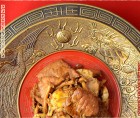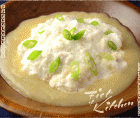the mission-old

I grew up in a Chinese food desert, both in time and place: the 70s in the middle of Iowa. My sister’s birthday was always something to fear because it spelled certain sweet and sour pork. I really thought I hated Chinese food.
My revelation came years ago at Wonton Garden on Mott Street in New York, where with eating with an insider friend who could go OFF-menu, I ate beef cheeks with rice cakes. Not only were rice cakes totally new to me (we’ll get to those later), but the richly beefy flavor of cheek meat (if you’ve never had it, it’s like a really tender, slow-cooked chuck roast) served in the same type of sauce and I had eaten so many times before—it was suddenly delicious. It occurred to me: Why do Chinese restaurants hold out on us? Why cook everything so fast? Restaurants use all the bland, tender cuts for fast cooking. Where does the rest of the animal go when all you get is loin or breast? Maybe this is why Americans have turned Chinese food into sauce-laden Wiener Schnitzel bites (note to self: make sauce-laden Wiener Schnitzel bites). Unless you know somewhere you can get off the menu, you’ll just have to make the good stuff at home.
There are so many things about this book we love, and reasons for cooking it. Firstly, these are home-cooking—not restaurant recipes—from 1936 China, edited for American housewives in 1956 (about the same food desert as ’70s Iowa). This makes for an interesting hole to cook our way out of: the recipes should be at the same more authentic because of their age, and less authentic because of the audience’s access to “exotic” ingredients. To correct this, we’ll be making regular trips to our local Asian market to find new ingredients and report on their effects. Our rule is: “authentic” or not, if it’s good it wins. Secondly, the story of the Benedictine Sisters is ready for a movie—the nonchalance of the introduction by Sister Francetta after spending WWII in a Chinese concentration camp has me begging to know the whole story. Hopefully we’ll be able to piece that story together as well. Thirdly, M. Nakamura’s illustrations on every page make this such a nice book to look at—at a time when food photography would more likely induce vomiting than appetite.
On Eat it: China! we’ll cook it the Sisters’ way, then we’ll find a better way to cook it. Our mission is to make this food as good as it can be, introducing new cooking techniques, meat cuts and ingredients. We won’t claim authenticity, we will only declare deliciousness!
—Matt
 Polynesian Spell
Polynesian Spell  pork, egg, and mushrooms
pork, egg, and mushrooms  Singapore Sling
Singapore Sling  pork with celery
pork with celery  Chicken Velvet
Chicken Velvet 